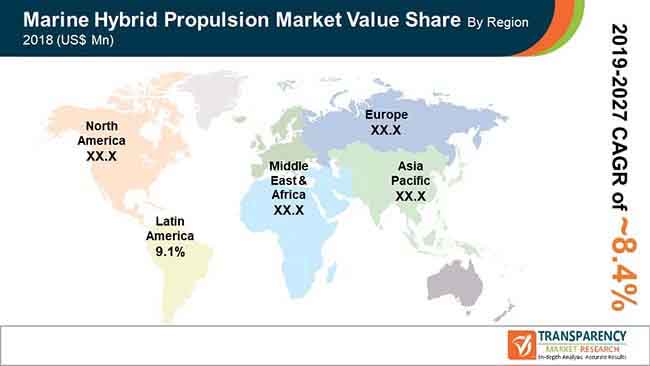10/20/2021
Marine Hybrid Propulsion Market-New Innovations, Research and Growth Factor till 2027
9/30/2021
Description of Global Marine Hybrid Propulsion Market
- Marine hybrid propulsion systems are gradually emerging as one of the most preferred clean propulsion systems globally and are being used in several vessel categories. One of the major advantages of using hybrid propulsion systems is their clean and efficient mechanism, which significantly lowers emissions as compared to conventional propulsion systems. Features such as silent maneuvering, emission-free operations, and lower degrees of fuel consumption have prompted vessel and towage operators to invest in this technology.
- Development of the technology originating from the hybrid automotive industry has assisted technology developers in designing efficient and economical marine hybrid propulsion systems. Marine hybrid propulsion systems are designed to use two independent drive systems for propulsion: a diesel engine and an electric motor, where electric power is generally stored in batteries or a super capacitor. The system utilizes the unused capacity of the main diesel engine to generate electricity and store it in batteries for later use.
Request A Sample-https://www.transparencymarketresearch.com/sample/sample.php?flag=S&rep_id=3911

Shift from Conventional to Hybrid Propulsion Units to Drive Global Marine Hybrid Propulsion Market
- The switch from fuel-based conventional propulsion to the environment-friendly hybrid variety is increasing owing to the latter’s efficiency and cost-effectiveness. Multiple ship operators are utilizing renewable energy including solar energy as a storage option in hybrid propulsion systems. In marine hybrid propulsion systems, stored solar energy is used during peak hours or at night, eliminating the round-the-clock need for conventional marine fuel
- Coupled with Stringent regulations related to minimization of harmful carbon emissions have propelled the demand for hybrid propulsion systems. The growing seaborne trade has resulted in the spillage of marine fuel into the marine ecosystem. Thus, governments of several countries are funding and supporting development and adoption of marine hybrid propulsion systems.
REQUEST FOR COVID19 IMPACT ANALYSIS-https://www.transparencymarketresearch.com/sample/sample.php?flag=covid19&rep_id=3911
Volatility in crude oil prices to Hamper Global Marine Hybrid Propulsion Market
- Marine hybrid systems utilize diesel, a byproduct of crude oil, for propulsion. Volatility in crude oil prices has resulted in a switch from diesel to LNG. The relatively low price of natural gas and LNG compared to diesel in North America and Europe has attracted investments in LNG bunkering infrastructure in these regions.
Europe and North America Highly Lucrative Region Global Marine Hybrid Propulsion Market
- Currently, ferries have been recognized as the major ends-user in terms of installation of marine hybrid propulsion systems. Ferry operators, especially in Europe, are anticipated to invest substantial amounts for the installation of hybrid propulsion systems in their respective vessels.
- The European Union has also supported upgrade of ferries as all vessels traversing through or operating in European waters have to reduce sulfur emissions from 2015. Defense vessels are anticipated to be one of the most prominent end-user segment in terms of future hybrid propulsion installations.
- Several defense organizations in Europe and North America have started installing hybrid propulsion systems in the respective vessels operated by them. The typical operating profile for naval destroyers and military vessels includes a significant amount of time voyaging at low speed. In such operating modes, electrical propulsion motors can be used to meet the vessel’s power requirement which significantly reduces emissions and saves fuel.
Purchase A Report-https://www.transparencymarketresearch.com/checkout.php?rep_id=3911<ype=S
Recent Developments in Global Marine Hybrid Propulsion Market
- By the end of 2020, Rolls-Royce is planning to bring in to the market a range of completely integrated MTU hybrid propulsion systems for ships, yachts, workboats, ferries and patrol boats. The propulsion systems will have a power range extending from around 1,000kW-4,000kW per powertrain. By this the company aiming to provide significant benefits to customers. The combination of diesel engines and electric motors, in addition to batteries, will provide efficiency, environmental compatibility and the flexibility of the propulsion system.
Other articles and publications:
Sclerotium Gum Market New Innovations, Research and Growth Factor till 2027
Ready-mix Joint Compounds Market – New Innovations, Research and Growth Factor till 2027
11/22/2021
Miniloaders Market – New Innovations, Research and Growth Factor till 2025
10/21/2021
Chlormequat Chloride Market – New Innovations, Research and Growth Factor till 2030
10/28/2021
Marine Hybrid Propulsion Market Trends, Regulations And Competitive Landscape Outlook to 2027
5/11/2022
Marine Hybrid Propulsion Market with Current Trends Analysis, 2019-2027
5/17/2022
Articles and publications of other companies:
5 Tips for Creating a Mobile-Friendly Ecommerce Website
8/1/2021
Are you fond of collecting guns for prestige or do you need guns for your safety because you prioritize safety than anything?
2/22/2021
You can forget about waiting on queues to purchase what you've managed to get. Buying clothes online is simple and saves a large amount of time friend of yours who's far from the area of yours.
3/9/2021
Business details
- +1 (518) 618-1030
- State Tower, 90 State Street, Suite 700, Albany NY - 12207, United States
We are the ‘difference’ between success and failure in business. It can’t get simpler than this in explaining what we are. A market research company, our reports and expertise into and outside your bu


